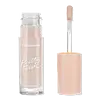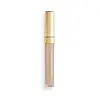What's inside
What's inside
 Key Ingredients
Key Ingredients

 Benefits
Benefits

 Concerns
Concerns

 Ingredients Side-by-side
Ingredients Side-by-side

Water
Skin ConditioningButylene Glycol
HumectantCaprylyl Methicone
Skin ConditioningDiisopropyl Dimer Dilinoleate
EmollientCyclopentasiloxane
EmollientDimethicone
EmollientLauryl PEG-10 Tris(Trimethylsiloxy)Silylethyl Dimethicone
EmulsifyingDimethicone/Vinyl Dimethicone Crosspolymer
Skin ConditioningNylon-12
Cetyl PEG/PPG-10/1 Dimethicone
EmulsifyingHexyl Laurate
EmollientPolyglyceryl-4 Isostearate
EmulsifyingSodium Chloride
MaskingPhenoxyethanol
PreservativeCaprylyl Glycol
EmollientGlycerin
HumectantSilica
AbrasivePyrus Malus Fruit Extract
Skin ConditioningBeeswax
Emulsion StabilisingDimethicone Crosspolymer
Emulsion StabilisingBHT
AntioxidantPotassium Sorbate
PreservativeSodium Hyaluronate
HumectantTocopheryl Acetate
AntioxidantTrisodium EDTA
Hexylene Glycol
EmulsifyingCocos Nucifera Water
MaskingSilica Silylate
EmollientCocos Nucifera Fruit Juice
EmollientTriethoxycaprylylsilane
Isopropyl Titanium Triisostearate
EmollientBis-PEG-15 Dimethicone/Ipdi Copolymer
PEG-2 Soyamine
EmulsifyingIron Oxides
CI 77891
Cosmetic ColorantWater, Butylene Glycol, Caprylyl Methicone, Diisopropyl Dimer Dilinoleate, Cyclopentasiloxane, Dimethicone, Lauryl PEG-10 Tris(Trimethylsiloxy)Silylethyl Dimethicone, Dimethicone/Vinyl Dimethicone Crosspolymer, Nylon-12, Cetyl PEG/PPG-10/1 Dimethicone, Hexyl Laurate, Polyglyceryl-4 Isostearate, Sodium Chloride, Phenoxyethanol, Caprylyl Glycol, Glycerin, Silica, Pyrus Malus Fruit Extract, Beeswax, Dimethicone Crosspolymer, BHT, Potassium Sorbate, Sodium Hyaluronate, Tocopheryl Acetate, Trisodium EDTA, Hexylene Glycol, Cocos Nucifera Water, Silica Silylate, Cocos Nucifera Fruit Juice, Triethoxycaprylylsilane, Isopropyl Titanium Triisostearate, Bis-PEG-15 Dimethicone/Ipdi Copolymer, PEG-2 Soyamine, Iron Oxides, CI 77891
Water
Skin ConditioningDimethicone
EmollientPhenyl Trimethicone
Skin ConditioningIsododecane
EmollientHydrogenated Polycyclopentadiene
Talc
AbrasiveButylene Glycol
HumectantPolyglyceryl-4 Isostearate
EmulsifyingCetyl PEG/PPG-10/1 Dimethicone
EmulsifyingHexyl Laurate
EmollientHydrogenated Castor Oil
EmollientHydrogenated Microcrystalline Cera
Silica
AbrasivePhenoxyethanol
PreservativeMica
Cosmetic ColorantTriethoxycaprylylsilane
Aluminum Hydroxide
EmollientBenzoic Acid
MaskingNiacinamide
SmoothingDisodium EDTA
Dehydroacetic Acid
PreservativePropylene Glycol
HumectantTrimethoxycaprylylsilane
SmoothingEthylhexylglycerin
Skin ConditioningBHT
AntioxidantAscorbic Acid
AntioxidantTin Oxide
AbrasiveSodium Hyaluronate
HumectantAcacia Seyal Gum Extract
HumectantPotassium Sorbate
PreservativeIsopropyl Alcohol
SolventCI 77891
Cosmetic ColorantCI 77492
Cosmetic ColorantCI 77491
Cosmetic ColorantCI 77499
Cosmetic ColorantWater, Dimethicone, Phenyl Trimethicone, Isododecane, Hydrogenated Polycyclopentadiene, Talc, Butylene Glycol, Polyglyceryl-4 Isostearate, Cetyl PEG/PPG-10/1 Dimethicone, Hexyl Laurate, Hydrogenated Castor Oil, Hydrogenated Microcrystalline Cera, Silica, Phenoxyethanol, Mica, Triethoxycaprylylsilane, Aluminum Hydroxide, Benzoic Acid, Niacinamide, Disodium EDTA, Dehydroacetic Acid, Propylene Glycol, Trimethoxycaprylylsilane, Ethylhexylglycerin, BHT, Ascorbic Acid, Tin Oxide, Sodium Hyaluronate, Acacia Seyal Gum Extract, Potassium Sorbate, Isopropyl Alcohol, CI 77891, CI 77492, CI 77491, CI 77499
 Reviews
Reviews

Ingredients Explained
These ingredients are found in both products.
Ingredients higher up in an ingredient list are typically present in a larger amount.
BHT is a synthetic antioxidant and preservative.
As an antioxidant, it helps your body fight off free-radicals. Free-radicals are molecules that may damage your skin cells.
As a preservative, it is used to stabilize products and prevent them from degrading. Specifically, BHT prevents degradation from oxidation.
The concerns related to BHT come from oral studies; this ingredient is currently allowed for use by both the FDA and EU.
However, it was recently restricted for use in the UK as of April 2024.
Learn more about BHTButylene Glycol (or BG) is used within cosmetic products for a few different reasons:
Overall, Butylene Glycol is a safe and well-rounded ingredient that works well with other ingredients.
Though this ingredient works well with most skin types, some people with sensitive skin may experience a reaction such as allergic rashes, closed comedones, or itchiness.
Learn more about Butylene GlycolThis ingredient is a high molecular weight silicone. It has emulsifying and skin conditioning properties.
Ci 77891 is a white pigment from Titanium dioxide. It is naturally found in minerals such as rutile and ilmenite.
It's main function is to add a white color to cosmetics. It can also be mixed with other colors to create different shades.
Ci 77891 is commonly found in sunscreens due to its ability to block UV rays.
Learn more about CI 77891Dimethicone is a type of synthetic silicone created from natural materials such as quartz.
What it does:
Dimethicone comes in different viscosities:
Depending on the viscosity, dimethicone has different properties.
Ingredients lists don't always show which type is used, so we recommend reaching out to the brand if you have questions about the viscosity.
This ingredient is unlikely to cause irritation because it does not get absorbed into skin. However, people with silicone allergies should be careful about using this ingredient.
Note: Dimethicone may contribute to pilling. This is because it is not oil or water soluble, so pilling may occur when layered with products. When mixed with heavy oils in a formula, the outcome is also quite greasy.
Learn more about DimethiconeHexyl Laurate isn't fungal acne safe.
Phenoxyethanol is a preservative that has germicide, antimicrobial, and aromatic properties. Studies show that phenoxyethanol can prevent microbial growth. By itself, it has a scent that is similar to that of a rose.
It's often used in formulations along with Caprylyl Glycol to preserve the shelf life of products.
This ingredient is an emulsifer and stabilizer. It comes from isostearic acid and polyglycerin.
As an emulsifier, it helps blend oil and water to improve texture, spreadbility, and application.
Due to it being derived from isostearic acid, this ingredient may not be fungal acne safe.
Learn more about Polyglyceryl-4 IsostearatePotassium Sorbate is a preservative used to prevent yeast and mold in products. It is commonly found in both cosmetic and food products.
This ingredient comes from potassium salt derived from sorbic acid. Sorbic acid is a natural antibiotic and effective against fungus.
Both potassium sorbate and sorbic acid can be found in baked goods, cheeses, dried meats, dried fruit, ice cream, pickles, wine, yogurt, and more.
You'll often find this ingredient used with other preservatives.
Learn more about Potassium SorbateSilica, also known as silicon dioxide, is a naturally occurring mineral. It is used as a fine, spherical, and porous powder in cosmetics.
Though it has exfoliant properties, the function of silica varies depending on the product.
The unique structure of silica enhances the spreadability and adds smoothness, making it a great texture enhancer.
It is also used as an active carrier, emulsifier, and mattifier due to its ability to absorb excess oil.
In some products, tiny microneedles called spicules are made from silica or hydrolyzed sponge. When you rub them in, they lightly polish away dead skin layers and enhance the penetration of active ingredients.
Learn more about SilicaSodium Hyaluronate is hyaluronic acid's salt form. It is commonly derived from the sodium salt of hyaluronic acid.
Like hyaluronic acid, it is great at holding water and acts as a humectant. This makes it a great skin hydrating ingredient.
Sodium Hyaluronate is naturally occurring in our bodies and is mostly found in eye fluid and joints.
These are some other common types of Hyaluronic Acid:
Learn more about Sodium HyaluronateTriethoxycaprylylsilane is a silicone used to bind and stabilize ingredients.
As an emulsifier, it helps prevent ingredients from separating. This can help elongate the shelf life of products.
Triethoxycaprylylsilane is often used to coat mineral sunscreens ingredients to help give a better feel. It also helps reduce oxidative stress in sunscreens.
Learn more about TriethoxycaprylylsilaneWater. It's the most common cosmetic ingredient of all. You'll usually see it at the top of ingredient lists, meaning that it makes up the largest part of the product.
So why is it so popular? Water most often acts as a solvent - this means that it helps dissolve other ingredients into the formulation.
You'll also recognize water as that liquid we all need to stay alive. If you see this, drink a glass of water. Stay hydrated!
Learn more about Water